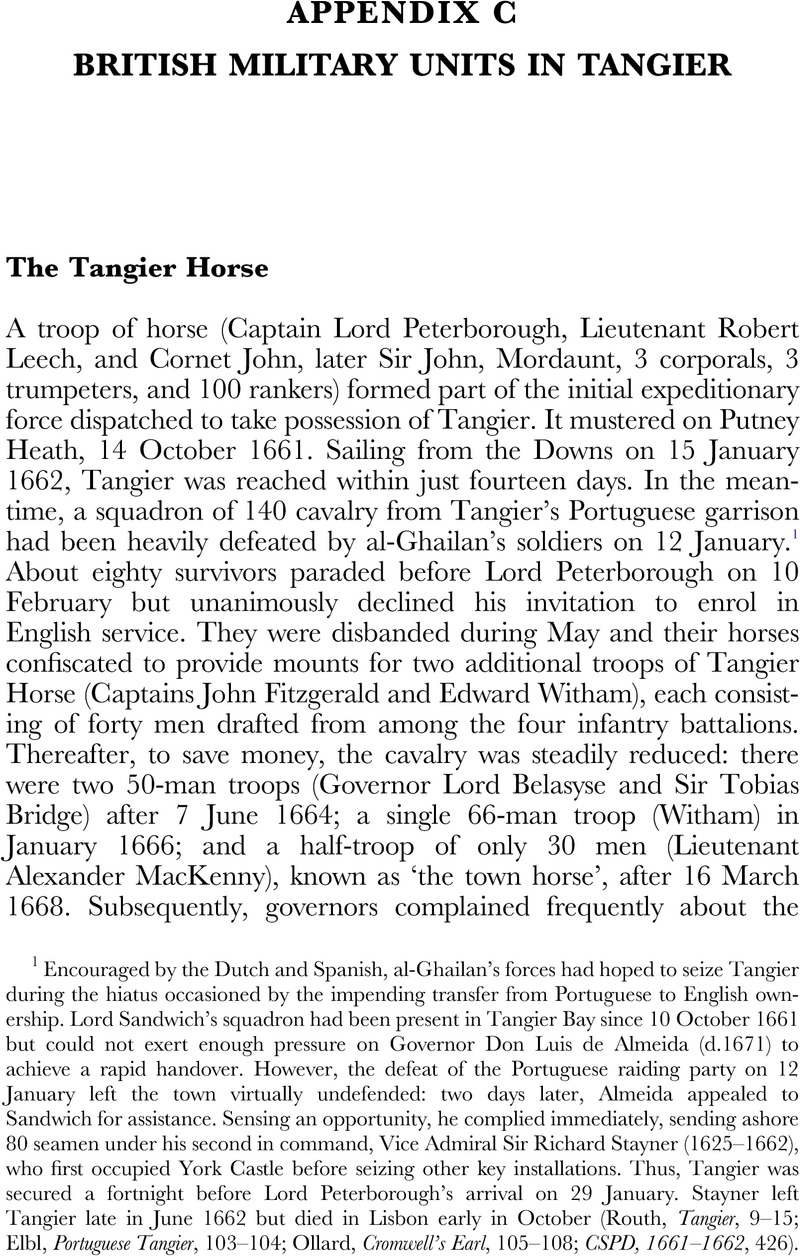No CrossRef data available.
Article contents
APPENDIX C BRITISH MILITARY UNITS IN TANGIER
Published online by Cambridge University Press: 09 November 2023
Abstract

- Type
- Appendices
- Information
- Copyright
- Copyright © The Author(s), 2023. Published by Cambridge University Press on behalf of Royal Historical Society
References
1 Encouraged by the Dutch and Spanish, al-Ghailan's forces had hoped to seize Tangier during the hiatus occasioned by the impending transfer from Portuguese to English ownership. Lord Sandwich's squadron had been present in Tangier Bay since 10 October 1661 but could not exert enough pressure on Governor Don Luis de Almeida (d.1671) to achieve a rapid handover. However, the defeat of the Portuguese raiding party on 12 January left the town virtually undefended: two days later, Almeida appealed to Sandwich for assistance. Sensing an opportunity, he complied immediately, sending ashore 80 seamen under his second in command, Vice Admiral Sir Richard Stayner (1625–1662), who first occupied York Castle before seizing other key installations. Thus, Tangier was secured a fortnight before Lord Peterborough's arrival on 29 January. Stayner left Tangier late in June 1662 but died in Lisbon early in October (Routh, Tangier, 9–15; Elbl, Portuguese Tangier, 103–104; Ollard, Cromwell's Earl, 105–108; CSPD, 1661–1662, 426).
2 Six officers, including Oglethorpe, were seconded from the Life Guards and six, including Sandys, from the Royal Horse Guards.
3 The political loyalty of the officers of these six, prospective troops was unimportant because they were destined to serve overseas.
4 After Ossory's death in London from typhus on 30 July 1680, his troop passed to Lieutenant Lewis Billingsley (b.1645) of Astley Abbots, Shropshire, on secondment from the 1st Troop of Life Guards.
5 These reinforcements were found from the sizeable reservoir of veterans variously created by the return of the British Brigade from France in January 1678, a dearth of mercenary work in Europe, and the disbandment of units raised for the Flanders expedition, 1678–1679, and the Bothwell Bridge campaign of 1679. On the fringes of the permanent English, Irish, and Scottish establishments, many of the recently demobilized professional officers and rankers remained in close touch ready to take advantage of any employment opportunities, preferably at home, but also abroad. For instance, there is considerable continuity among the personnel that fought in the Duke of Monmouth's Regiment of Horse in France during the 1670s; Monmouth's Horse in England, 1678–1679; Brandon's cavalry regiment, 1679; the three troops of Tangier Horse levied in July 1680; and the Royal Dragoons, 19–24 November 1683 (Childs, Nobles, Gentlemen, xiv–xv; Dalton, Army Lists, I. 203, 268, 301).
6 When de la Rue was promoted lieutenant of MacKenny's troop, 25 April 1682, William Davis became adjutant. In 1683, Davis was succeeded by Henry Hawker (Drenth and Riley, I. 115).
7 Each troop horse, plus furniture (saddle, bridle, collar, and holsters), cost £20 from the Life Guard and £17 from the Royal Horse Guards.
8 CO 279/28, fo. 63.
9 Atkinson, Royal Dragoons, 8–33; Dalton, Army Lists, I. 268, 301; Drenth and Riley, I. 114–117, 141–142; Routh, Tangier, 12–15, 185–186, 243–245, 374–375; Childs, Kirke, 44; Gibler, Douglas M., International Military Alliances, 1648–2008, 2 vols (Washington DC, 2009), II. 26–28CrossRefGoogle Scholar; Narcisco Feliú de la Peña y Farell, Anales de Cataluña y Epilogo Breve (Barcelona, 1709), 417, 431; Gleig, II. 49; Kenyon, Sunderland, 53; Davis, Queen's, I. 175; Ross, 19–20; Tangier Texts, 189; Pepys, Diary, III. 33; The Journal of the 1st Earl of Sandwich, 1659–1665, ed. R.C. Anderson, Navy Records Society, 64 (1928), 114–115; HMC, Dartmouth MSS, I. 84–86; CSPD, 1663–1664, 246, 249, 313, 327, 419, 422, 437, 629; CSPD, 1679–1680, 554, 557, 584; CSPD, 1680–1681, 29; CSPD, 1683–1684, 100, 105, 111, 236, 400; CSPD, 1684–1685, 79; CSPD, Addenda 1660–1685, 103; CTB, 1660–1667, 428; CTB, 1679–1680, 681.
10 Dalton, Army Lists, I. 9, 33, 277–278; Drenth and Riley, I. 103–134; Leslie, Succession, 41–43; Childs, Army of Charles II, 115; Childs, Kirke, 63–64; Davis, Queen's, I. 1–16; CSPD, 1684–1685, 6–7, 133; CSPD, Addenda 1660–1685, 103. See Letter 113.
11 Childs, Kirke, 39–40; Routh, Tangier, 184; Dalton, Army Lists, I. 295; Drenth and Riley, I. 132–134; Leslie, Succession, 44–45; Davis, Queen's, I. 183, 187; CSPD, 1679–1680, 551–552, 554, 596; CSPD, 1684–1685, 6–7, 133; STRO, Legge Papers, D(W)1778/I/i/563.
12 Childs, Kirke, 33–4, 63, 197; Leslie, Succession, 40–41; Halkett, Diary, 1–24; CSPD, 1679–1680, 538; CSPD, 1684–1685, 6–7; HMC, Fitzherbert MSS, 9.
13 The two companies from the 1st Foot Guards’ were led by a captain, three lieutenants, an ensign, and twelve NCOs. Only two lieutenants were allowed in the three remaining companies.
14 Childs, Kirke, 34, 39, 198; Davis, Queen's, I. 159, 250, 261–262, 308; Routh, Tangier, 318; Drenth and Riley, I. 136–137; Ross, 3–4; CSPD, 1679–1680, 494, 573; CSPD, 1680–1681, 18, 82–84, 88, 100, 102; CTB, 1685–1689, 287–288.
15 Drenth and Riley, I. 130; Childs, Army of Charles II, 184–195; Dalton, Army Lists, I. 255, 258; HMC, Bath MSS, II. 169; CSPD, 1685, 278; CSPD, 1690–1691, 311.
16 Cholmley, An Account of Tangier, 6–10; Rodrigues, Vitor Luis Gaspar, ‘The Portuguese Art of War in Northern Morocco during the 15th Century’, Athens Journal of History, 10 (2017), 8–9, 12Google Scholar; Davis, Queen's, I. 128; Drenth and Riley, I. 145–146; Routh, Tangier, 311–313. See Letter 28.




